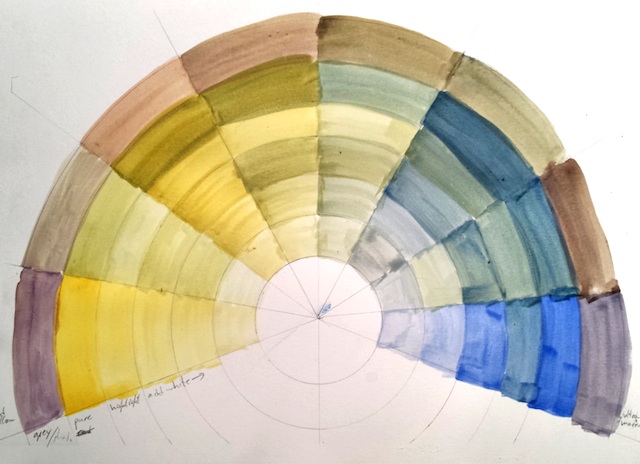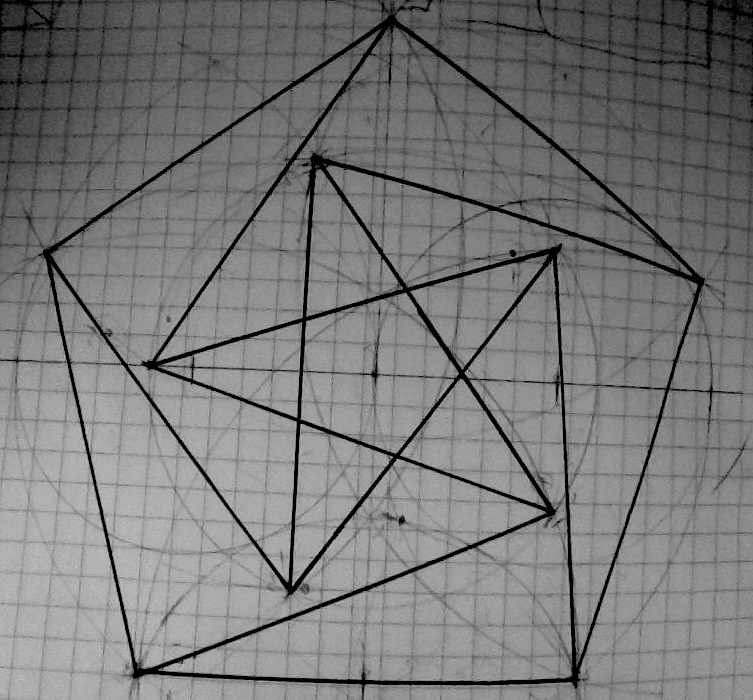Five 2-Colourings of the Petersen Graph
“You just want to give the impression of bushes,” said my painting instructor.
What is an “impression” of the Petersen graph? The tension between art and mathematical concepts often sets artistic expression against details, similar to my instructor’s trees. A “mathematical impressionism” emerges in which the scene is a mathematical concept, and the impressionist delivers their artistic representation of it.
I challenged myself to explicitly highlight several mathematical concepts in
“Five 2-Colourings of the Petersen Graph”, and to give a tastefully
didactic impression of this champion of discrete
mathematics. 
Please view all six works by clicking the buttons inside the box below.

Sources and Other Details:
The Petersen graph is a beautiful graph. At least, that is what graph theorists will tell you, time and again, yet, a Google image search reveals a jumble of dots connected by lines. At best, these drawings are sometimes star-shaped, or possess some symmetry, but their mathematical beauty is often quite hidden to the layperson. I was thus inspired to paint five portraits that show the Petersen graph’s potential for visual beauty.
Here, in the “about the works” page, I explain how I went about making the drawings and writing the description. The five paintings of the graph are penned with acrylic india ink, using various calligraphy nibs, and they are coloured with ultramarine blue and cadmium yellow watercolours. I also used small amounts of other colours to create shades and highlights. The calligraphy was also done with a pen dipped in acrylic india ink, and the tatami frieze patterns were done with green archival stamp ink, using little stamps carved in pencil erasers. Finally, the mixed-media version of the 6-cycle drawing is done with old kodak photo development sheets in some version of cyan, magenta, yellow, and “transparent”.

Four of the five paintings of the graph have 5-fold symmetry, and to draw these accurately and efficently, I used the compass and straight-edge construction for a pentagon given at Math Open Reference.
Inevitably, I had to refresh my memory and learn some new things about the graph. The main resources I used are Wikipedia, this explanation of the cycle-double-cover conjecture, several pages about the real projective plane, about embedding in the RPP, about various other things, the Kneser graphs, and finally, I had some help with the unit-distance drawing. In addition, I received some very helpful communications from Prof. Matt DeVos of Simon Fraser University.
One major challenge was the fact that I did not know how to paint when I started this project. I began with basic brushing and blending techniques by Lorraine Watry, and then lessons on using colours, by Dennis Clark and a newly acquired colour wheel. Following this, I painted about 40 experimental versions over photocopies of the pen drawings of my graphs.

The bottom line was that I felt that I gained enough experience to properly use
two colours. 
After a brief study of ultramarine blue and cadmium yellow, I began to work on the final pieces…

The works are on display at the
School of Engineering and Computing Sciences, at
Durham
University. 

Tatami Frieze patterns
I used tatami coverings of infinite strip, related to my
PhD dissertation to decorate the text. These
are (exact) coverings of an infinitely wide strip with $1\times 1$ and $1\times 2$
and $2\times 1$ tiles in which no four tiles meet at one point. The coverings I
used represent the 7 distinct frieze
patterns. 
About Alejandro Erickson:
Alejandro is a self-taught visual artist with a background in mathematics and theoretical computer science. Born in Vancouver, Canada in 1982, Alejandro took to photography and other art projects at a young age. in 2009 he combined his interests in art and mathematics to produce a traveling show of mathematical sculptures, varying from palm sized pieces to monumental works up to two stories tall. Some of these continue to travel with Math Catcher, a project which has the purpose of inspiring young Aboriginal students and their peers with mathematics. In 2010, Alejandro co-designed and commercialised Zero sumZ and Zero sumZ mini; a challenging mathematical card game with very simple rules, similar to the Set Card Game. Alejandro realised the concept central to his doctoral work on locally restricted tilings as a mechanical sculpture which was published and demonstrated as TatamiMaker in 2013 at an international conference on Math and Art, called Bridges.
Alejandro is a postdoctoral research associate at Durham University in the UK, and he dedicates much of his spare time to experiments in Art and Math.
Please contact alejandro.erickson(remove this bit) at gmail.com for comments and inquiries about sales, leases, or commissions.



